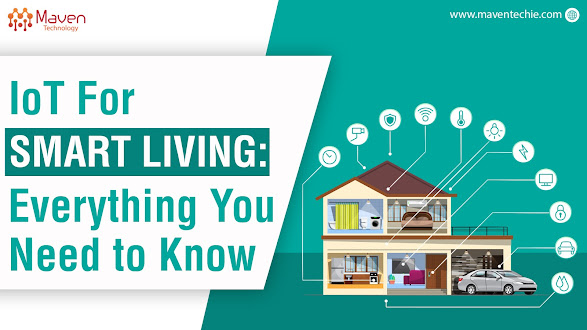Know the Future of Living: IoT for Smart Living | Maven Technology
Get ready to witness a digital revolution in your smart home infrastructure. The future of IoT solutions has covered every other industry revolution, and it's about to explode with over 29 billion devices worldwide by 2030!
The growth and adoption of Internet of Things (IoT) devices worldwide is projected to be significant in the coming years. By the end of 2030, the number of IoT devices is expected to nearly double to over 29 billion.
And!
By the end of 2024, it is projected that there will be over 207 billion connected devices globally, expanding beyond traditional computers and smartphones.
The IoT solutions and their ecosystem will encompass a vast range of devices, from household items like smartwatches to complex industrial machinery. These devices will increasingly leverage artificial intelligence (AI) capabilities, enabling autonomous decision-making.
China will be at the forefront, embracing the power of technology with a staggering 8 billion consumer IoT devices! Can you imagine the possibilities?
Businesses across industries and consumer markets have already realized the benefits of IoT, leading to its widespread implementation. The consumer segment accounted for around 60 percent of all IoT-connected devices in 2020, and this proportion is expected to remain consistent in the next decade.
As we progress towards 2024, the distinction between the physical and digital realms will continue to blur as the Internet of Things becomes more ingrained in our daily lives.
The proliferation of wearables and connected products demonstrates this ongoing trend of integrating IoT into various aspects of our lives.
Cross-Industry Verticals and Use Cases IoT Solutions!
Major industry verticals with currently over 100 million connected IoT devices include :
Electricity, Gas, Steam & A/C
Water Supply & Waste Management
Retail & Wholesale
Smart Cities
Transportation & Storage
Government
The number of IoT devices is forecasted to grow to more than eight billion across all industry verticals by 2030.
In the consumer segment, the most important use case for IoT devices is consumer internet & media devices, such as smartphones. The number of IoT devices in this segment is projected to exceed 17 billion by 2030.
Other use cases with more than one billion IoT devices by 2030 include :
Connected (Autonomous) Vehicles
Healthcare
IT Infrastructure
Agriculture
Connected Vehicles
Predictive Maintenance
Asset Tracking & Monitoring
Smart Grid.
Data Analytics
Act of Internet of Things (IoT) for Smart Home
The emergence of IoT Solutions For Smart Homes has brought about a transformative shift, connecting and enhancing our living environments.
By facilitating communication between devices, appliances, and homeowners, IoT Solutions transforms conventional homes into smart, automated spaces.
Below Are Some Important Functions That IoT Fulfills in Smart Homes :
Automation and Control :
IoT enables automation and control of various devices and appliances in a smart home. With IoT solutions, homeowners can easily control and automate tasks such as adjusting thermostat settings, turning on/off lights, managing home entertainment systems, and controlling home security systems, all from a centralized platform or through voice commands.
Remote Access and Monitoring :
IoT allows homeowners to access and monitor their smart home devices and appliances remotely. By using smartphones or tablets, homeowners can remotely control the temperature, monitor security cameras, lock or unlock doors, and even receive notifications about any unusual activities or emergencies in their homes.
Energy Efficiency :
IoT solutions provide homeowners with real-time energy monitoring and optimization, helping them reduce energy consumption and lower utility bills. Smart thermostats can learn residents' schedules and preferences to automatically adjust temperature settings for optimal energy efficiency. Additionally, IoT-enabled smart lighting systems can automatically turn off lights when rooms are unoccupied.
Enhanced Security and Safety :
IoT devices enable advanced security and safety features in smart homes. Smart security systems can integrate sensors, cameras, and alarms to detect and alert homeowners about potential threats. IoT-enabled smoke detectors and carbon monoxide sensors can send immediate alerts to homeowners' smartphones in case of emergencies.
Personalized Experiences :
IoT solutions can personalize the living experience in smart homes. For example, smart speakers with virtual assistants can learn the preferences and habits of homeowners to provide personalized recommendations or reminders. IoT can also enable intelligent home entertainment systems that adjust sound settings or playlists based on the residents present in the room.
IoT solutions bring various benefits to smart homes, enhancing convenience, security, energy efficiency, and personalization. By connecting devices and appliances, IoT allows for seamless automation, remote access, and personalized experiences, transforming traditional houses into intelligent and connected living spaces.
How About IoT in Smart Home Works?
The Internet of Things (IoT) in smart homes is made possible by a network of interconnected devices, sensors, and a central network system.
This network allows for seamless communication and control of various aspects of the home—such as lighting or temperature.
Here’s a Simplified Illustration of How IoT Technology in Smart Homes Works :
Overall, the growth of IoT and its adoption in both consumer and industrial sectors signifies the increasing reliance on connected devices and the potential for innovation and improved efficiency in various industries.
Whether you're a tech enthusiast, an entrepreneur, or just curious about the IoT revolution, this is an exciting time to act! Join us on this journey as we dive into the endless possibilities of a connected world.
Device Connectivity :
IoT devices in a smart home, such as smart thermostats, smart lights, and smart appliances, are connected to a network. This can be a local Wi-Fi network or a dedicated IoT network like Zigbee or Z-Wave.
Data Collection and Transmission :
IoT devices and sensors collect data about various aspects of the home environment, such as temperature, humidity, motion, or energy consumption. This data is then transmitted to the central network system or cloud server for processing and analysis.
Central Hub Processing:
Smart homes have a central hub or gateway that acts as the control center. This hub receives and processes the data from the devices and sensors, making sense of it and initiating appropriate actions based on predefined rules or user preferences. The hub can also integrate with voice assistants or smartphone apps for user interaction and control.
Automation and Control :
Based on the data collected and processed, the central hub can automate various tasks and control the connected devices. For example, if the hub detects that no one is in a room, it can automatically turn off the lights and adjust the temperature to save energy. It can also trigger security measures like activating alarms or sending notifications if a sensor detects unusual activity.
User Interaction :
Smart homes provide users with different interfaces for controlling and interacting with the system. This can be through smartphone apps, voice commands to virtual assistants like Amazon Alexa or Google Assistant, or dedicated control panels. Users can remotely monitor and control devices, set schedules, create automation rules, and receive notifications or alerts.
Overall, IoT in smart homes works by connecting devices, collecting and analyzing data, and enabling automation and control to create a seamless and intelligent living environment. Users can interact with their smart homes through various interfaces to customize and manage their home settings, making their lives more convenient, comfortable, and secure.
IoT technology enables automation and convenience in smart homes through seamless device communication and control.
It creates an IoT-connected device ecosystem where devices work together to create smart residency circumstances.
Homeowners can conveniently monitor and control their smart homes from anywhere using the central hub and user interfaces, offering more flexibility and control over their living spaces.
Also Read : Top Internet of Things (IoT) Trends for 2024 : How Will IoT Change in the Future? : Click Here : https://maventechie.com/en/blog/top-internet-of-things-iot-trends-for-2024-how-will-iot-change-in-the-future/
Most Definite IoT Smart Home Technologies
Smart homes use various IoT technologies for connectivity and automation, such as :
Wi-Fi : Wi-Fi is a popular networking technology that enables connectivity between devices in smart homes. Wi-Fi-enabled IoT devices can be easily connected to home networks, providing access to the internet and cloud services.
Zigbee : Zigbee is a low-power, low-data-rate wireless technology popularly used in many smart home devices. Zigbee is designed for the Internet of Things and can connect a wide range of devices, including sensors, lighting systems, and thermostats.
Z-Wave : Z-Wave is another low-power, mesh networking technology used in smart homes. Z-Wave allows for secure and reliable communication between IoT devices and can connect up to 232 devices on a single network.
Smart Sensors : Sensors are key for collecting real-time data about the home environment. They detect temperature, humidity, light intensity, water supply, unauthorized entry, fire alarm alerts, and more, providing valuable information for automating functions in the smart home.
Voice Assistants : Voice assistants, like Amazon Alexa or AI-powered virtual assistant 'Google Assistant', and iOS voice Assistant 'Siri' are popular in smart homes IoT systems, as they enable voice recognition and intuitive control through voice commands.
Thread : Thread is a new wireless networking protocol that is designed specifically for smart home devices. Thread provides reliable, low-power, and secure communication between devices, making it ideal for building different types of smart home products.
NFC : Near Field Communication (NFC) enables secure and simple communication between two smart devices nearby. NFC technology can be used in smart homes to enable simpler pairing of devices and to provide safety features like keyless door locks.
Cloud Services : Cloud services provide a centralized platform for managing and controlling IoT devices in smart homes. Through cloud connectivity, homeowners can remotely monitor and manage their devices, access real-time data, and receive alerts and notifications.
These IoT technologies work together to create a seamless and fully integrated smart home experience. By enabling connectivity, automation, and control, these technologies provide homeowners with greater convenience, comfort, security, and energy efficiency.
RESOURCE URL : https://www.linkedin.com/pulse/know-future-living-iot-smart-maven-technology-ltd-04jvf/




Awesome blog.
ReplyDeleteThanks for sharing!
Ready to take your web experience to the next level? Connect with us for exceptional Progressive Web Apps (PWAs) development services that combine cutting-edge technology with creative design to deliver outstanding results.